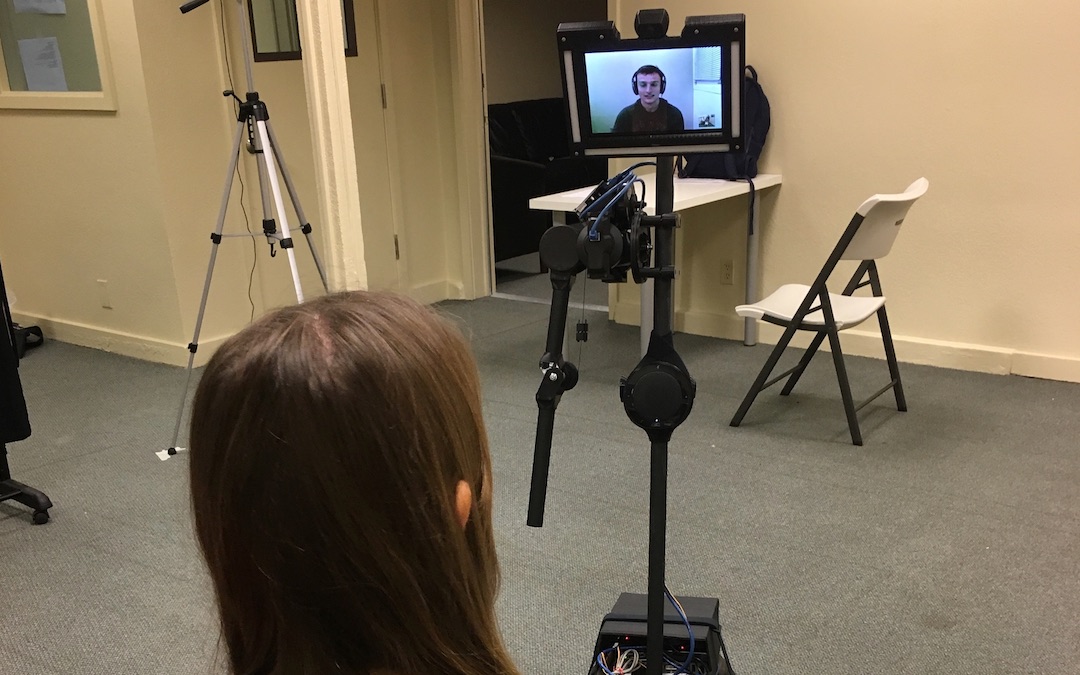Telepresence for SAR
We aim to better understand use cases of mobile robots that connect people with far-away environments through videoconferencing and navigation.

Problem
Much of our work in this area to date focuses on the potential of telepresence robots to improve remote access to the classroom environment. There is a significant need for tools to keep remote students connected to the classroom; as of 2015, approximately 14% of university students in the United States pursue postsecondary degrees using exclusively distance education courses. Another 15% have taken some courses in-person and at least one course using distance learning technologies. These students, especially those who are never able to attend class in person, can experience detriments in both learning outcomes and social connections with peers.
Solution
Telepresence robots hold the potential to make distance learning more immersive through their ability to allow users to communicate with and navigate through distant environments. Past work has begun to qualitatively explore teleconferencing and telepresence robots to support remote students, but much of this work has been qualitative in nature. We strive to better understand telepresence experiences and use cases through quantitative measurements across multiple controlled conditions, in addition to studies that consider various covariate important in telepresence.
Publications
- Naomi T. Fitter, Megan Strait, Eloise Bisbee, Maja J. Matarić, and Leila Takayama, "You’re wigging me out! Is personalization of telepresence robots strictly positive?," Paper accepted to the ACM/IEEE International Conference on Human-Robot Interaction (HRI), Boulder, CO, USA (remote), 2021. [BibTeX] [PDF]
- Naomi T. Fitter, Nisha Raghunath, Elizabeth Cha, Christopher A. Sanchez, Leila Takayama, and Maja J. Matarić, "Are we there yet? Comparing remote learning technologies in the university classroom," Robotics and Automation Letters, 2020. [BibTeX] [PDF]
- Naomi T. Fitter, Luke Rush, Elizabeth Cha, Thomas Groechel, Maja Matarić, and Leila Takayama, "Closeness is key over long distances: Effects of interpersonal closeness on telepresence experience," Proceedings of the ACM/IEEE International Conference on Human-Robot Interaction (HRI), Cambridge, U.K. (remote), 2020. [BibTeX] [PDF]
- Naomi T. Fitter, Youngseok Joung, Zijian Hu, Marton Demeter, and Maja J. Matarić, "User interface tradeoffs for remote deictic gesturing," Proceedings of the IEEE International Symposium on Robot and Human Interactive Communication (RO-MAN), New Delhi, India, 2019. [BibTeX] [PDF]
- Naomi T. Fitter, Youngseok Joung, Marton Demeter, Zijian Hu, and Maja J. Matarić, "Design and evaluation of expressive turn-taking hardware for a telepresence robot," Proceedings of the IEEE International Symposium on Robot and Human Interactive Communication (RO-MAN), New Delhi, India, 2019. [BibTeX] [PDF]
- Naomi T. Fitter and Maja J. Matarić, "Increasing self-awareness for telepresence robot users," Proceedings of the IROS Workshop on Assistance and Service Robotics in a Human Environment, held in conjunction with the IEEE/RSJ International Conference on Intelligent Robots and Systems (IROS), Madrid, Spain, 2018. [BibTeX] [PDF]
- Naomi T. Fitter, Elizabeth Cha, and Maja J. Matarić, "Comparing remote learning technologies," Proceedings of the RSS Workshop on Fundamental Issues in Symbiotic Human-Robot Interaction, held in conjunction with the Robotics Science and Systems (RSS) Conference, Pittsburgh, PA, USA, 2018. [BibTeX] [PDF]
- Naomi T. Fitter, Yasmin Chowdhury, Elizabeth Cha, Maja J. Matarić, Leila Takayama, "Evaluating the effects of personalization on telepresence robots for education," Companion of the 2018 ACM/IEEE International Conference on Human-Robot Interaction (HRI), Chicago, IL, USA, 2018. [BibTeX] [PDF]
